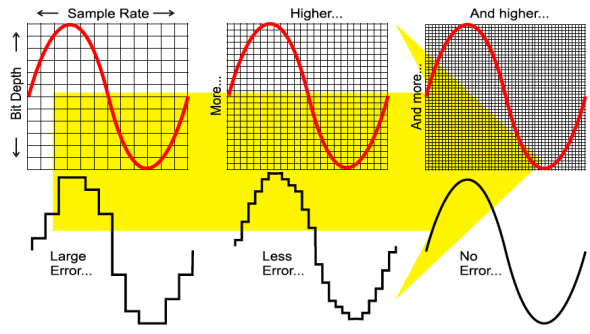What is Dithering Audio?
Dithering is the process of masking quantisation errors when mapping digital bits to an analog wave. We prevent noise patterns by randomising how the final digital bit gets rounded to 1 or 0, and mask them it with uncorrelated noise (randomised noise).
We use dithering to add noise to our audio signal. This allows us, audio engineers, to make quantization noise far less perceivable. Quantisation noise occurs when we are reducing the bit depth of an audio signal.
By using analog to digital converters, we undergo the process of quantisation. This process is where sample rate & bit depth hold important places in the digital audio world. We recommend reading our bit depth article if you’re unfamiliar with what quantisation is!

What is Bit Depth, Quantization Noise and Distortion?
To summarise, when recording an analog source into a system, bit depth sets out the number of potential amplitude values for your recorded sound. This determines the total dynamic range of the recorded digital audio.
However, the acoustic wave doesn’t always line up with a digital value. By rounding up or down to 1 or 0 the final bit that represents amplitude, we are quantizing and totally randomising a part of the signal.
Therefore, quantization noise is the difference between your original signal and your quantized signal.
By rounding your analog wave to a bit depth that doesn’t accurately represent its amplitude, quantization distortion occurs at lower bit depths because of the limited number of digital bits available.
The quantization process can create certain patterns, and we call this correlated noise. Correlated noise is particular resonances in the noise floor at certain frequencies in definitive parts of the audio. In these parts, our noise floor is higher than elsewhere and is taking up more amplitude values that the recorded signal cannot get access to.
Quantization noise sounds just like noise because it is. However, it sounds like distortion when you severely lower the bit depth of the signal. This rounds off the signal in a fashion not so different from a square wave.
With this in mind, distortion only happens when bit depth reduction is severe enough to produce a square wave.
What Does Dithering Do?
Dithering is the noise we introduce to an audio signal that masks the noise generated from random quantization.
Dithering is the process of masking quantisation errors by randomising how the final digital bit gets rounded. This creates uncorrelated noise (randomised noise), rather than correlated noise, and leaves room for more amplitude values, and this puts the amplitude of the noise floor at the bottom of our dynamic range.
Now that we’ve randomised the noise that quantisation has created, it’s now more difficult to hear them in the audio. They’re still there, but our ears can’t hear them so well because there are no definitive patterns anymore.
We know what you’re thinking. “Are we just swapping the harmonic distortion that quantisation has created… for more noise?”
Yes, we are.

When Should I Use Dithering?
As we mentioned, quantization noise/distortion is far more noticeable when we reduce a higher bit depth file to a lower bit depth.
Therefore, use dithering to mask the effects of quantization noise when you reduce a higher bit depth file to a lower bit depth file.
But only use dithering in the mastering process, and it only when quantization noise is noticeable.
Because 16-bit files are the standard for music streaming, it isn’t uncommon to reduce 32-bit or 24-bit file to 16-bit depth. This happens during the mastering process and is probably the only time this reduction will happen.
As you’re reducing your bit depth from a 32-bit or 24-bit file to a 16-bit file, you’re not creating quantization distortion. This is because the reduction in bit depth is not severe enough, so you’re creating quantization noise.
You may have noticed that some limiter plugins feature a dithering function. This is because dithering is only implemented at the very end of a signal chain, right before you bounce the audio out to a file.
So, the next time you need to lower the bit depth of your killer track that you conjured using Mixxed samples, you have full knowledge of what’s happening!
What Are the Different Types of Dithering?
There are 3 types of dithering that are commonly known, and these are POW-r 1, 2, and 3. The difference between them is minimal and even arguable. But each has its own use, so it’s worth being aware of them.
POW-r = Psychoacoustically Optimized Wordlength Reduction
We would use Type 1 POW-r when working with mixes that have a low dynamic range, like very compressed tracks. Type 1 POW-r is noise with a flat frequency noise. This means there is no noise shaping in type 1 because no EQ has shaped the introduced noise.
Type 2 POW-r dithering is what we would use for speech/dialogue audio. It features noise shaping (an EQ has shaped the noise) that attenuates the noise at 2kHz. It also amplifies it at 14kHz and upward. This ensures the added noise is effective in masking quantization distortion, but not itself perceivable.
Finally, we would use Type 3 POW-r dithering for recordings that have large dynamic ranges, such as orchestral music. Noise shaping has shaped the noise but is different to type 2 because the attenuated & amplified frequencies are greater. The EQ applied to the noise is much greater than in type 2.
What is Noise Shaping?
Noise shaping is a technique we use with dithering to increase the audible signal-to-noise ratio. We use noise shaping to accurately attenuate or amplify specific frequency bands in our noise signal where we need either more or less noise.
What is Rectangular Probability Density Function (RPDF)?
RPDF dither noise has an equal distribution. This means that any value of noise that you specify inside a range has an equal probability of occurring.
What is Triangular Probability Density Function (TPDF)?
TPDF dither noise has a triangular-shaped distribution. This means that any specified noise values in the centre of your range have a much higher probability of occurring. By adding two sources of TPDF, you can create RPDF dithering.
What is Gaussian PDF?
Gaussian PDF has what we call a “normal distribution“. The relationship between probabilities of results follows a Gaussian curve which is bell-shaped. This is the common dither created by analog sources like mic preamps. If you have a digital audio recording with a high bit depth, the preamp noise will introduce any needed dither.

What is Coloured Dither?
Coloured dither is dither that’s filtered to be distinguishable from white noise.
Coloured dither has more energy in the higher frequency bands so that the critical frequency band has less energy and is less perceivable.
